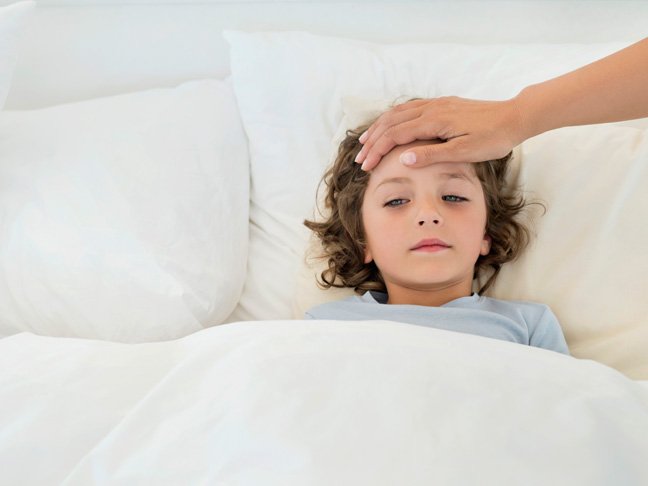Fevers are a big topic in my pediatrics practice. After all, they’re common. Nearly all children will develop a fever at some point in their lives. Fevers are also upsetting and even overwhelming for parents. As a parent of three boys, I can sympathize with those feelings; it’s stressful when your child is running a fever and feeling miserable! As a pediatrician, however, I know that fevers are not usually dangerous. There are a lot of myths out there about fevers, such as they can fry a baby’s brain, which are just false. In fact, a fever means that your child’s immune system is hard at work fighting off an infection. Read on for the real deal about fevers.
What temperature is considered a fever?
Medically speaking, a fever is any temperature above 38 °C. A normal body temperature is anywhere between 36.1 °C and 37.9 °C.
Is there such a thing as a fever that’s too high?
I get asked this question all the time, and here’s the thing: there is no magic number. A child with a 40.3 °C fever isn’t necessarily any sicker than one with a fever of 38.2 °C. What matters most is the duration of the fever and your child’s behavior once the temperature comes down. Children with high fevers may seem irritable or out of it; however, as the medication kicks in to bring down the temperature, your child should seem like a more recognizable version of herself. As a doctor, I am more worried about a child whose temperature is 37.7 °C, but is very fussy versus a child who has a temperature of 40 °C and is running around after taking medication. In addition, if your child has a fever for more than three days, we recommend they see a doctor.
What’s the difference between Children’s Tylenol and Children’s Motrin?
Both products work differently to relieve your child’s fever (or pain) because they contain different active ingredients. Children’s Tylenol contains Acetaminophen which can be used as the first line of defense against pain or fever and won’t upset your child’s tummy. Children’s Motrin contains Ibuprofen which helps to fight a persistent fever and lasts up to 8 hours. So, it’s a good idea to keep both medications in your medicine cabinet at home.
Are fevers dangerous?
Having a fever is your child’s natural response to fighting infection. Though fevers may feel scary (especially your child’s first fever) they are not usually dangerous. However, when running a fever, your child may feel uncomfortable and therefore there are medications available to help bring down your child’s temperature so he can be more comfortable.
Should babies always receive medicine for fevers?
You do not have to give your child medication just because she has a fever. The fever itself is not dangerous. The reason behind giving her medication is to make her more comfortable. If your child has a temperature of 38.3 °C but is playing, drinking fluids, and running around like a lunatic, then you can wait and see how she does. If she seems uncomfortable it is a good idea to give her the medicine so she feels better. Tylenol (which has acetaminophen) can be given every four hours. Ibuprofen (the active ingredient in Motrin) can be given every 6 hours once your child is over six months of age. How much medication you give your child is based on her weight (see this helpful dosing chart).
Can fevers give children brain damage?
Having a fever is the body’s physiologic response to fighting infection. Fevers will not “fry” or “melt” your child’s brain. There is a small subset of children who can have seizures with fever; these are referred to as febrile seizures. These events are uncommon and studies have shown many times that fever reducers do not prevent febrile seizures. In fact, nothing has been proven to prevent febrile seizures currently. If your child does have a febrile seizure, you should call 911.
When should I seek medical attention?
- The child is less than 2-months-old and has a rectal temperature greater than 100.4 degrees
- He has had persistent fevers for more than three days in a row
- She is very irritable, despite the fever having gone down
- He is extremely sleepy and you are having difficulty awakening him
- She is having trouble breathing
- You are not sure how to handle the situation (or you feel concerned about your child’s condition)
Remember, treating the fever with a fever reducer will bring down your child’s temperature but does not take care of the underlying illness. It is likely that once the medication wears off, your child will have fever again. In most cases, time, fluids, and fever reducers are all he will need to get back to his normal self.
More Advice from Dr. Blanchard:
- Secondary Drowning: How to Recognize the Signs
- Strep Throat: Everything You Need to Know
- All About Ear Infections
Photo: Getty









